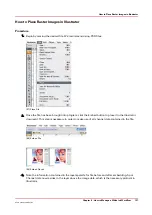
How to Create Spot Data in Photoshop
Introduction
This section explains how to prepare images that include spot data with raster-based image
editing applications such as Adobe Photoshop®. In order to print with white ink or varnish, you
must have an ONYX profile (media model) properly configured for the use of spot data.
To add spot color data to your image in PhotoShop, you need to create a layer within the image
as a new spot channel. It is possible to have more than one spot element in an image, but each
element must be on the same spot channel, and therefore have the same opacity level, or else
ProductionHouse will treat the saved document as a separation file. Since the Arizona printers
with white ink or varnish support two spot channels, you can create one spot channel for Spot 1
data and another for Spot 2 data. CMYK is the preferred image mode as the actions required for
spot data creation are simpler than those for RGB.
NOTE
You can use raster-based image editing applications other than Photoshop as long as it has the
ability to create spot channels.
Purpose
When you have a raster-based image and need to have select areas of that image show up as
white when the media is non-white or clear or translucent, you can prepare a spot channel for the
white data in Photoshop.
When to do
The first step in the white ink or varnish workflow is to prepare your source image to use a spot
ink channel. The spot data must be designed entirely on a separate channel (either as a spot
channel layer or a custom spot color) to be recognized by the Onyx RIP. The name you assign to
this spot channel layer or custom spot color must be Spot 1 or Spot 2 and is the most important
part of preparing the file. This named channel allows RIP-Queue to determine that the data in the
source image needs to be output to the spot channel. In preparing your file, only you can define
what you want to print with "white ink" or "varnish" as part of your design and assign the color as
described in this document. Using your graphic application program, the spot data can be simple
or complex and can range from vector shapes and text to halftone bitmap images.
New Spot Channel Layer
Use the following steps to create a new spot channel layer:
Procedure
1.
Open the desired file in PhotoShop (if the file is in RGB mode, then convert it to CMYK mode).
2.
Use the desired selection tool (e.g. the Magic Wand) to select the area of the image you wish to
print with white ink.
NOTE
The image file used in this example is for illustration purposes only. For best results
when working with text, we recommend that you use a vector-based program such as
Adobe Illustrator.
3.
In PhotoShop, ensure that the Channels tab is visible (under the Window menu click Channels to
view the panel).
4.
Click the arrow on the Channels tab to display the Channels menu.
How to Create Spot Data in Photoshop
Chapter 9 - How to Manage a White Ink Workflow
129
Océ Arizona 1200 Series
Summary of Contents for arizona 1240 GT
Page 1: ...User guide Oc Arizona 1200 Series Revision 3010121377...
Page 6: ...Contents 6 Oc Arizona 1200 Series...
Page 7: ...Chapter 1 Introduction...
Page 11: ...Chapter 2 Product Compliance...
Page 15: ...Chapter 3 Safety Information...
Page 34: ...Roll Media Safety Awareness 34 Chapter 3 Safety Information Oc Arizona 1200 Series...
Page 35: ...Chapter 4 How to Navigate the User Interface...
Page 56: ...Software Update Module 56 Chapter 4 How to Navigate the User Interface Oc Arizona 1200 Series...
Page 57: ...Chapter 5 How to Operate Your Oc Arizona Printer...
Page 78: ...Media Registration 78 Chapter 5 How to Operate Your Oc Arizona Printer Oc Arizona 1200 Series...
Page 79: ...Chapter 6 Operating the Oc Arizona 1200 XT...
Page 85: ...Chapter 7 Roll Media Option...
Page 109: ...Chapter 8 Static Suppression Option...
Page 113: ...Chapter 9 How to Manage a White Ink Workflow...
Page 157: ...Chapter 10 Ink System Management...
Page 161: ...Chapter 11 Troubleshooting...
Page 163: ...Chapter 12 Printer Maintenance...
Page 207: ...Appendix A Application Information...






























